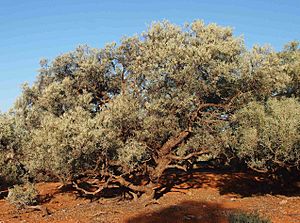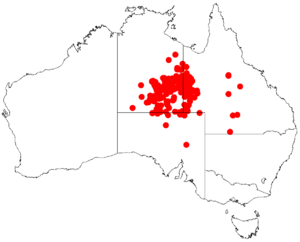Acacia georginae facts for kids
Quick facts for kids Acacia georginae |
|
|---|---|
 |
|
| Scientific classification | |
| Genus: |
Acacia
|
| Species: |
georginae
|
 |
|
| Occurrence data from AVH | |
| Synonyms | |
|
Racosperma georginae (Bailey) Pedley |
|
Acacia georginae is a perennial tree which is native to arid areas of central Australia and has been introduced into the United States. Common names for it include Georgina gidgee, Georgina gidyea and poison gidyea.
Contents
Description
The tree typically grows to a height of 3 to 8 m (9.8 to 26.2 ft) and has a dense crown with grey to white hairy branchlets. Like most species of Acacia it has phyllodes rather than true leaves. The grey-green hairy phyllodes have a narrowly elliptic shape and are straight to slightly recurves with a length of 4 to 11 cm (1.6 to 4.3 in) and a width of 4 to 16 mm (0.16 to 0.63 in) have one to three more prominent nerves than the many others that are closely parallel and indistinct in comparison. It blooms between May and August and produces seed pods between September and December.
Taxonomy
The species was first formally described by the botanist Frederick Manson Bailey in 1896 as a part of the work Botany. Contributions to the Flora of Queensland as published in the Botany Bulletin. Department of Agriculture, Queensland. It was reclassified as Racosperma georginae by Leslie Pedley in 1987 then transferred back to genus Acacia in 2001. The specific epithet recognizes the place that the type specimen was collected, along the Georgina River.
Distribution
Georgina gidgee woodlands have a patchy but widespread distribution in central Australia and are considered Vulnerable (VU) according to the IUCN Red List of Ecosystems. It is widely distributed through arid parts central and eastern Australia from the south eastern Northern Territory in the west extending into Queensland to around the catchment of the Georgina River in the north east and into the far north east of South Australia in the south east where it is usually situated along water courses or on plains growing in loamy or clay soils as a part of low open woodland communities.
Uses
Its uses include timber and fuel. Primarily the seed pods can be extremely poisonous, since they may contain what are called organic fluoroacetates. Unfortunately, sheep and cattle sometimes are poisoned after grazing on the pods.

